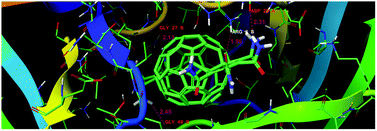Receptor- and ligand-based study of fullerene analogues: comprehensive computational approach including quantum-chemical, QSAR and molecular docking simulations†
Abstract

* Corresponding authors
a
Interdisciplinary Center for Nanotoxicity, Department of Chemistry and Biochemistry, Jackson State University, 1400 J.R. Lynch Street, P.O. Box 17910, Jackson, MS 39217, USA
E-mail:
rasulev@icnanotox.org
Fax: +1-601-979-6865
Tel: +1-601-979-3723
b Department of Civil and Environmental Engineering, Jackson State University, 1400 J.R. Lynch Street, P.O. Box 17068, Jackson, MS 39217, USA

 Please wait while we load your content...
Something went wrong. Try again?
Please wait while we load your content...
Something went wrong. Try again?
L. Ahmed, B. Rasulev, M. Turabekova, D. Leszczynska and J. Leszczynski, Org. Biomol. Chem., 2013, 11, 5798 DOI: 10.1039/C3OB40878G
To request permission to reproduce material from this article, please go to the Copyright Clearance Center request page.
If you are an author contributing to an RSC publication, you do not need to request permission provided correct acknowledgement is given.
If you are the author of this article, you do not need to request permission to reproduce figures and diagrams provided correct acknowledgement is given. If you want to reproduce the whole article in a third-party publication (excluding your thesis/dissertation for which permission is not required) please go to the Copyright Clearance Center request page.
Read more about how to correctly acknowledge RSC content.
 Fetching data from CrossRef.
Fetching data from CrossRef.
This may take some time to load.
Loading related content
